Evaluation of the Performance, Liquidity, and Financial Structure of Tesco
VerifiedAdded on 2023/06/18
|9
|1347
|250
AI Summary
This report evaluates Tesco's financial performance and position using accounting ratios. It also discusses limitations of accounting ratios and factors affecting the company. The report concludes that Tesco's gross profit margin is increasing, but its current ratio is decreasing. Brexit is considered a major factor affecting the company.
Contribute Materials
Your contribution can guide someone’s learning journey. Share your
documents today.
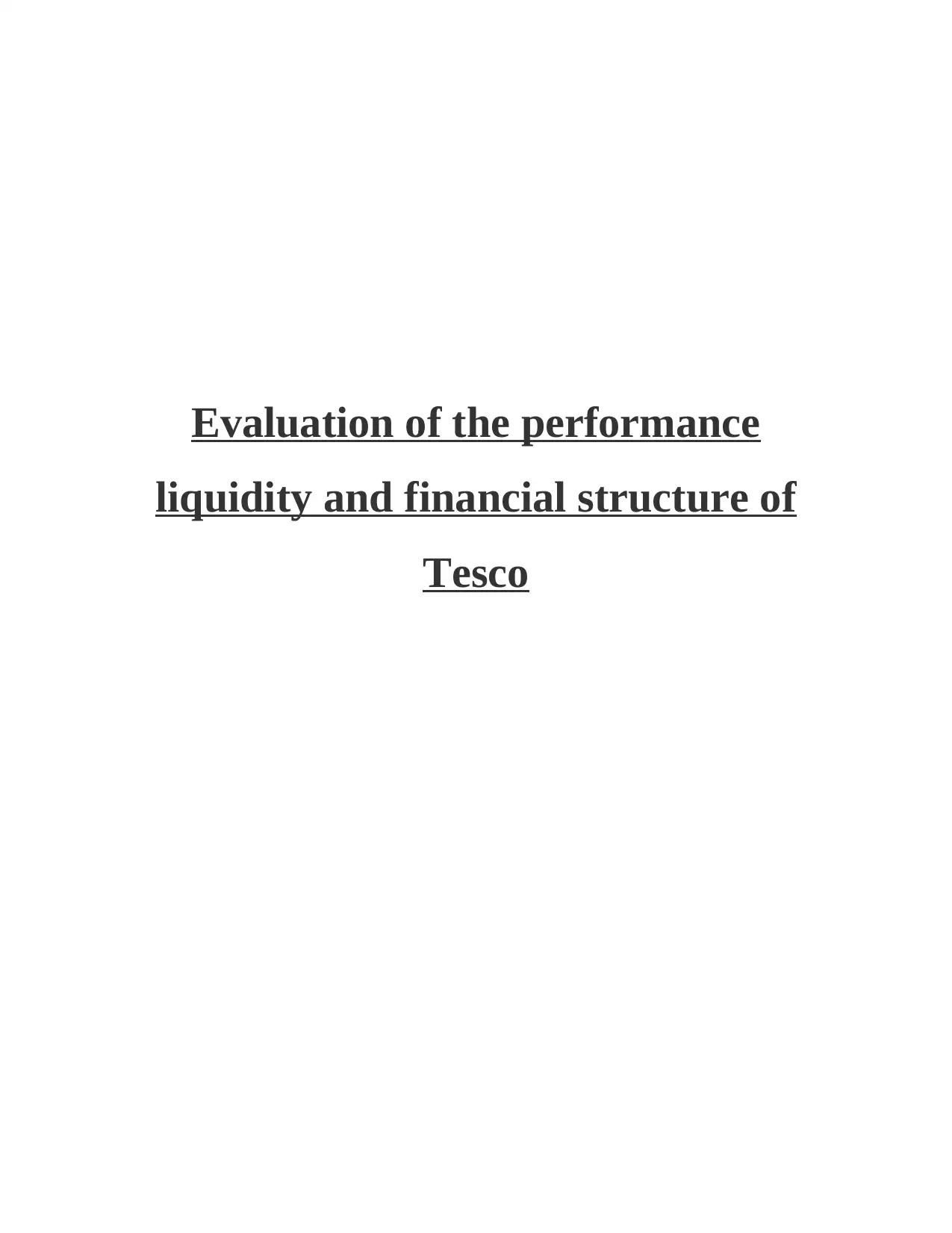
Evaluation of the performance
liquidity and financial structure of
Tesco
liquidity and financial structure of
Tesco
Secure Best Marks with AI Grader
Need help grading? Try our AI Grader for instant feedback on your assignments.
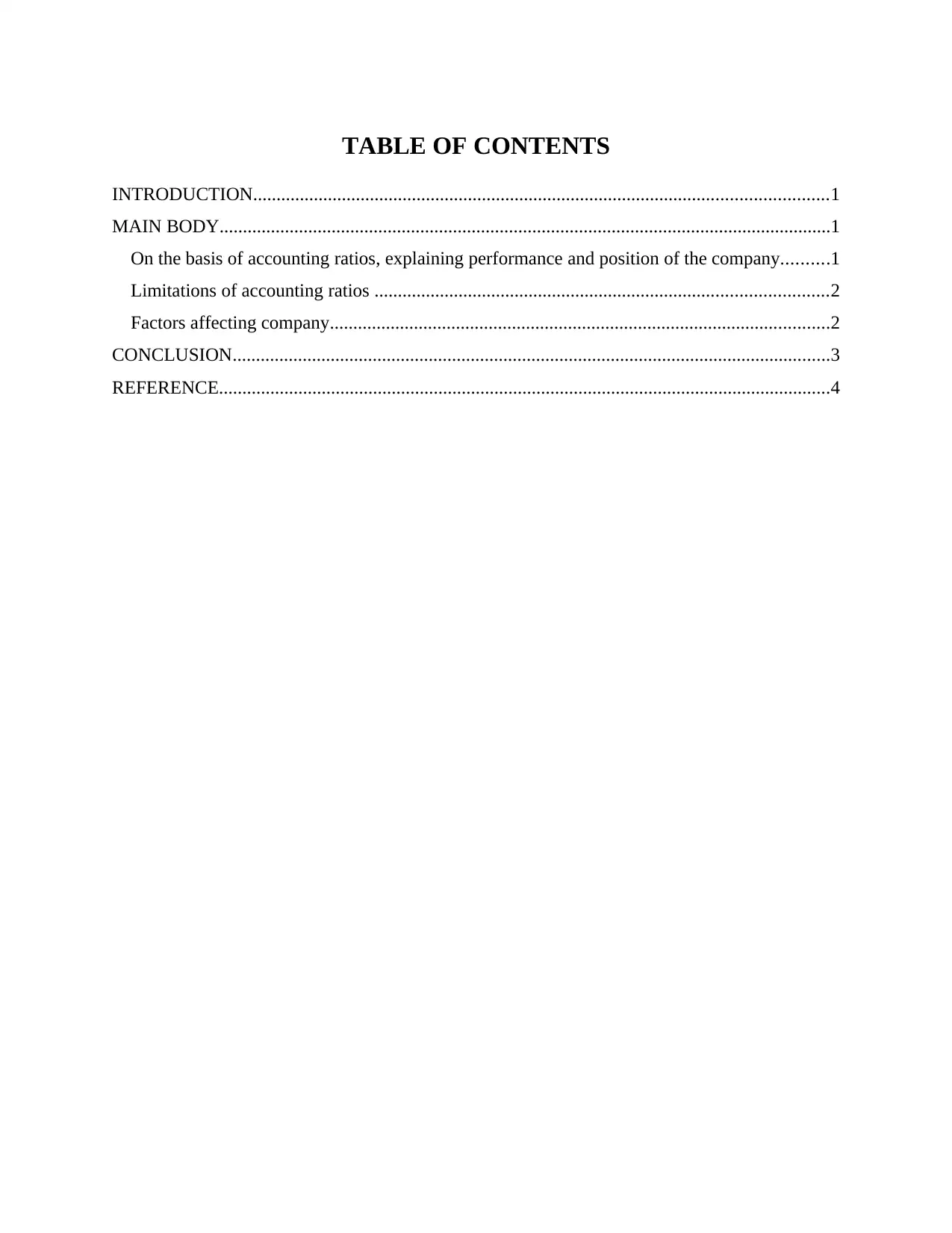
TABLE OF CONTENTS
INTRODUCTION...........................................................................................................................1
MAIN BODY...................................................................................................................................1
On the basis of accounting ratios, explaining performance and position of the company..........1
Limitations of accounting ratios .................................................................................................2
Factors affecting company...........................................................................................................2
CONCLUSION................................................................................................................................3
REFERENCE...................................................................................................................................4
INTRODUCTION...........................................................................................................................1
MAIN BODY...................................................................................................................................1
On the basis of accounting ratios, explaining performance and position of the company..........1
Limitations of accounting ratios .................................................................................................2
Factors affecting company...........................................................................................................2
CONCLUSION................................................................................................................................3
REFERENCE...................................................................................................................................4
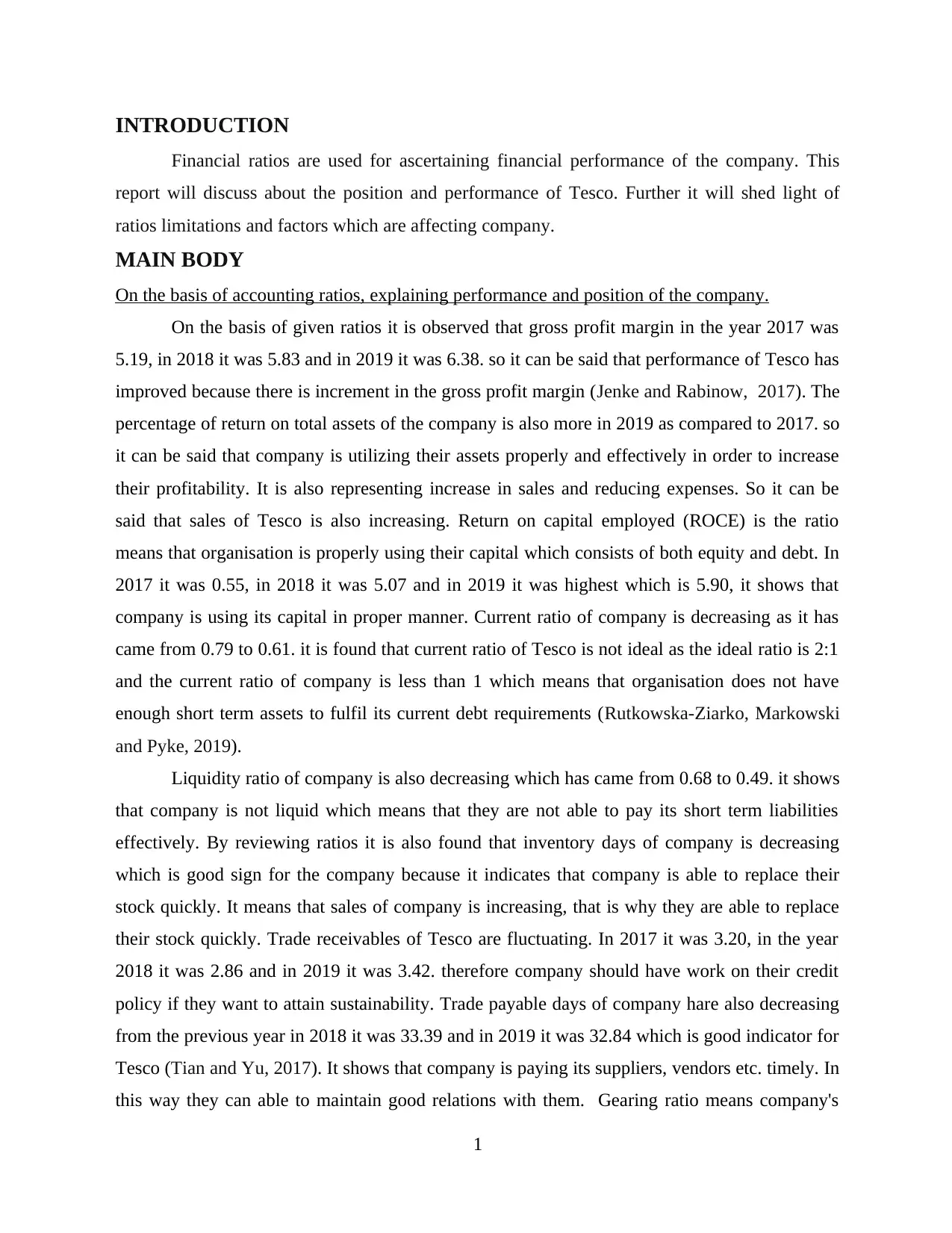
INTRODUCTION
Financial ratios are used for ascertaining financial performance of the company. This
report will discuss about the position and performance of Tesco. Further it will shed light of
ratios limitations and factors which are affecting company.
MAIN BODY
On the basis of accounting ratios, explaining performance and position of the company.
On the basis of given ratios it is observed that gross profit margin in the year 2017 was
5.19, in 2018 it was 5.83 and in 2019 it was 6.38. so it can be said that performance of Tesco has
improved because there is increment in the gross profit margin (Jenke and Rabinow, 2017). The
percentage of return on total assets of the company is also more in 2019 as compared to 2017. so
it can be said that company is utilizing their assets properly and effectively in order to increase
their profitability. It is also representing increase in sales and reducing expenses. So it can be
said that sales of Tesco is also increasing. Return on capital employed (ROCE) is the ratio
means that organisation is properly using their capital which consists of both equity and debt. In
2017 it was 0.55, in 2018 it was 5.07 and in 2019 it was highest which is 5.90, it shows that
company is using its capital in proper manner. Current ratio of company is decreasing as it has
came from 0.79 to 0.61. it is found that current ratio of Tesco is not ideal as the ideal ratio is 2:1
and the current ratio of company is less than 1 which means that organisation does not have
enough short term assets to fulfil its current debt requirements (Rutkowska-Ziarko, Markowski
and Pyke, 2019).
Liquidity ratio of company is also decreasing which has came from 0.68 to 0.49. it shows
that company is not liquid which means that they are not able to pay its short term liabilities
effectively. By reviewing ratios it is also found that inventory days of company is decreasing
which is good sign for the company because it indicates that company is able to replace their
stock quickly. It means that sales of company is increasing, that is why they are able to replace
their stock quickly. Trade receivables of Tesco are fluctuating. In 2017 it was 3.20, in the year
2018 it was 2.86 and in 2019 it was 3.42. therefore company should have work on their credit
policy if they want to attain sustainability. Trade payable days of company hare also decreasing
from the previous year in 2018 it was 33.39 and in 2019 it was 32.84 which is good indicator for
Tesco (Tian and Yu, 2017). It shows that company is paying its suppliers, vendors etc. timely. In
this way they can able to maintain good relations with them. Gearing ratio means company's
1
Financial ratios are used for ascertaining financial performance of the company. This
report will discuss about the position and performance of Tesco. Further it will shed light of
ratios limitations and factors which are affecting company.
MAIN BODY
On the basis of accounting ratios, explaining performance and position of the company.
On the basis of given ratios it is observed that gross profit margin in the year 2017 was
5.19, in 2018 it was 5.83 and in 2019 it was 6.38. so it can be said that performance of Tesco has
improved because there is increment in the gross profit margin (Jenke and Rabinow, 2017). The
percentage of return on total assets of the company is also more in 2019 as compared to 2017. so
it can be said that company is utilizing their assets properly and effectively in order to increase
their profitability. It is also representing increase in sales and reducing expenses. So it can be
said that sales of Tesco is also increasing. Return on capital employed (ROCE) is the ratio
means that organisation is properly using their capital which consists of both equity and debt. In
2017 it was 0.55, in 2018 it was 5.07 and in 2019 it was highest which is 5.90, it shows that
company is using its capital in proper manner. Current ratio of company is decreasing as it has
came from 0.79 to 0.61. it is found that current ratio of Tesco is not ideal as the ideal ratio is 2:1
and the current ratio of company is less than 1 which means that organisation does not have
enough short term assets to fulfil its current debt requirements (Rutkowska-Ziarko, Markowski
and Pyke, 2019).
Liquidity ratio of company is also decreasing which has came from 0.68 to 0.49. it shows
that company is not liquid which means that they are not able to pay its short term liabilities
effectively. By reviewing ratios it is also found that inventory days of company is decreasing
which is good sign for the company because it indicates that company is able to replace their
stock quickly. It means that sales of company is increasing, that is why they are able to replace
their stock quickly. Trade receivables of Tesco are fluctuating. In 2017 it was 3.20, in the year
2018 it was 2.86 and in 2019 it was 3.42. therefore company should have work on their credit
policy if they want to attain sustainability. Trade payable days of company hare also decreasing
from the previous year in 2018 it was 33.39 and in 2019 it was 32.84 which is good indicator for
Tesco (Tian and Yu, 2017). It shows that company is paying its suppliers, vendors etc. timely. In
this way they can able to maintain good relations with them. Gearing ratio means company's
1
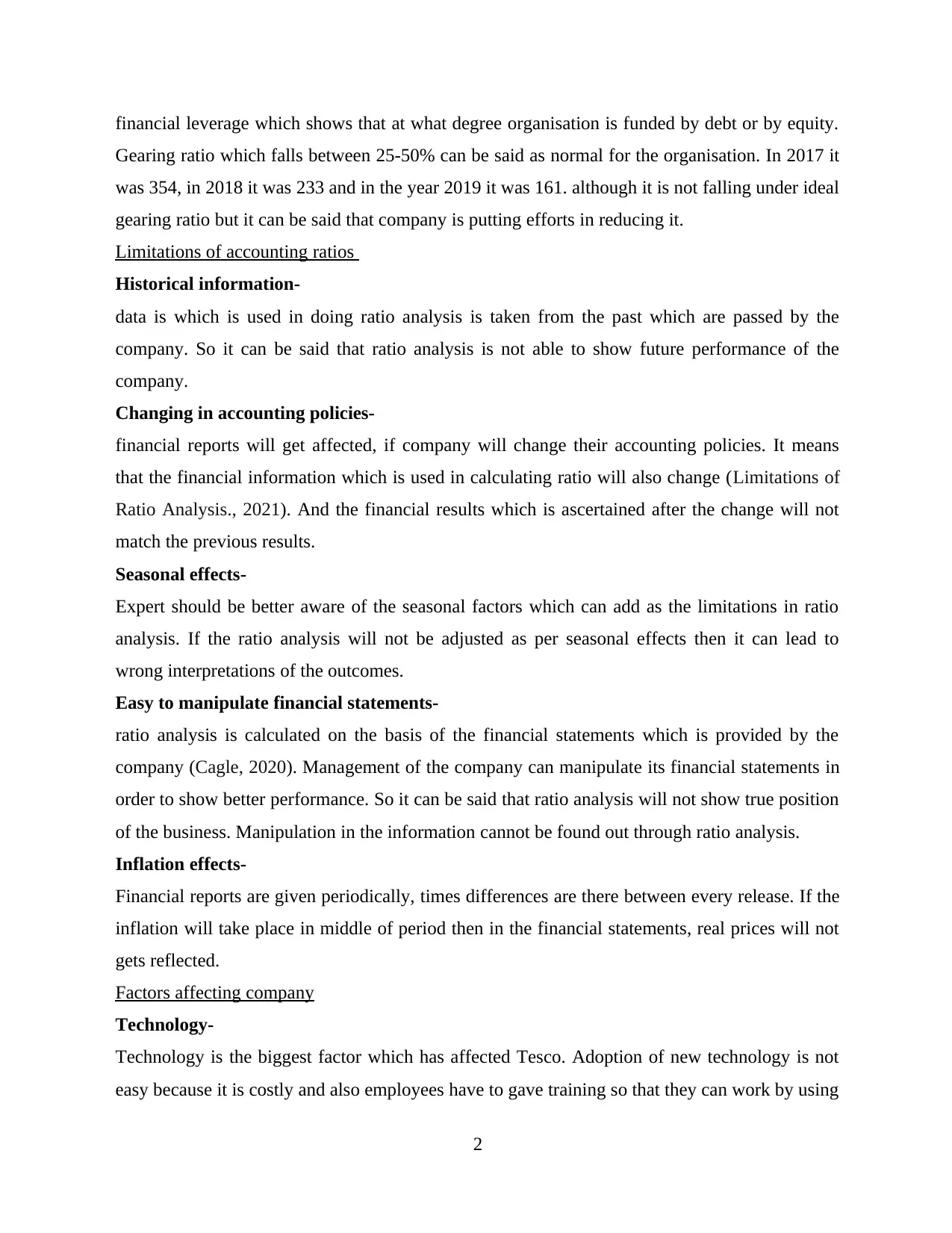
financial leverage which shows that at what degree organisation is funded by debt or by equity.
Gearing ratio which falls between 25-50% can be said as normal for the organisation. In 2017 it
was 354, in 2018 it was 233 and in the year 2019 it was 161. although it is not falling under ideal
gearing ratio but it can be said that company is putting efforts in reducing it.
Limitations of accounting ratios
Historical information-
data is which is used in doing ratio analysis is taken from the past which are passed by the
company. So it can be said that ratio analysis is not able to show future performance of the
company.
Changing in accounting policies-
financial reports will get affected, if company will change their accounting policies. It means
that the financial information which is used in calculating ratio will also change (Limitations of
Ratio Analysis., 2021). And the financial results which is ascertained after the change will not
match the previous results.
Seasonal effects-
Expert should be better aware of the seasonal factors which can add as the limitations in ratio
analysis. If the ratio analysis will not be adjusted as per seasonal effects then it can lead to
wrong interpretations of the outcomes.
Easy to manipulate financial statements-
ratio analysis is calculated on the basis of the financial statements which is provided by the
company (Cagle, 2020). Management of the company can manipulate its financial statements in
order to show better performance. So it can be said that ratio analysis will not show true position
of the business. Manipulation in the information cannot be found out through ratio analysis.
Inflation effects-
Financial reports are given periodically, times differences are there between every release. If the
inflation will take place in middle of period then in the financial statements, real prices will not
gets reflected.
Factors affecting company
Technology-
Technology is the biggest factor which has affected Tesco. Adoption of new technology is not
easy because it is costly and also employees have to gave training so that they can work by using
2
Gearing ratio which falls between 25-50% can be said as normal for the organisation. In 2017 it
was 354, in 2018 it was 233 and in the year 2019 it was 161. although it is not falling under ideal
gearing ratio but it can be said that company is putting efforts in reducing it.
Limitations of accounting ratios
Historical information-
data is which is used in doing ratio analysis is taken from the past which are passed by the
company. So it can be said that ratio analysis is not able to show future performance of the
company.
Changing in accounting policies-
financial reports will get affected, if company will change their accounting policies. It means
that the financial information which is used in calculating ratio will also change (Limitations of
Ratio Analysis., 2021). And the financial results which is ascertained after the change will not
match the previous results.
Seasonal effects-
Expert should be better aware of the seasonal factors which can add as the limitations in ratio
analysis. If the ratio analysis will not be adjusted as per seasonal effects then it can lead to
wrong interpretations of the outcomes.
Easy to manipulate financial statements-
ratio analysis is calculated on the basis of the financial statements which is provided by the
company (Cagle, 2020). Management of the company can manipulate its financial statements in
order to show better performance. So it can be said that ratio analysis will not show true position
of the business. Manipulation in the information cannot be found out through ratio analysis.
Inflation effects-
Financial reports are given periodically, times differences are there between every release. If the
inflation will take place in middle of period then in the financial statements, real prices will not
gets reflected.
Factors affecting company
Technology-
Technology is the biggest factor which has affected Tesco. Adoption of new technology is not
easy because it is costly and also employees have to gave training so that they can work by using
2
Secure Best Marks with AI Grader
Need help grading? Try our AI Grader for instant feedback on your assignments.
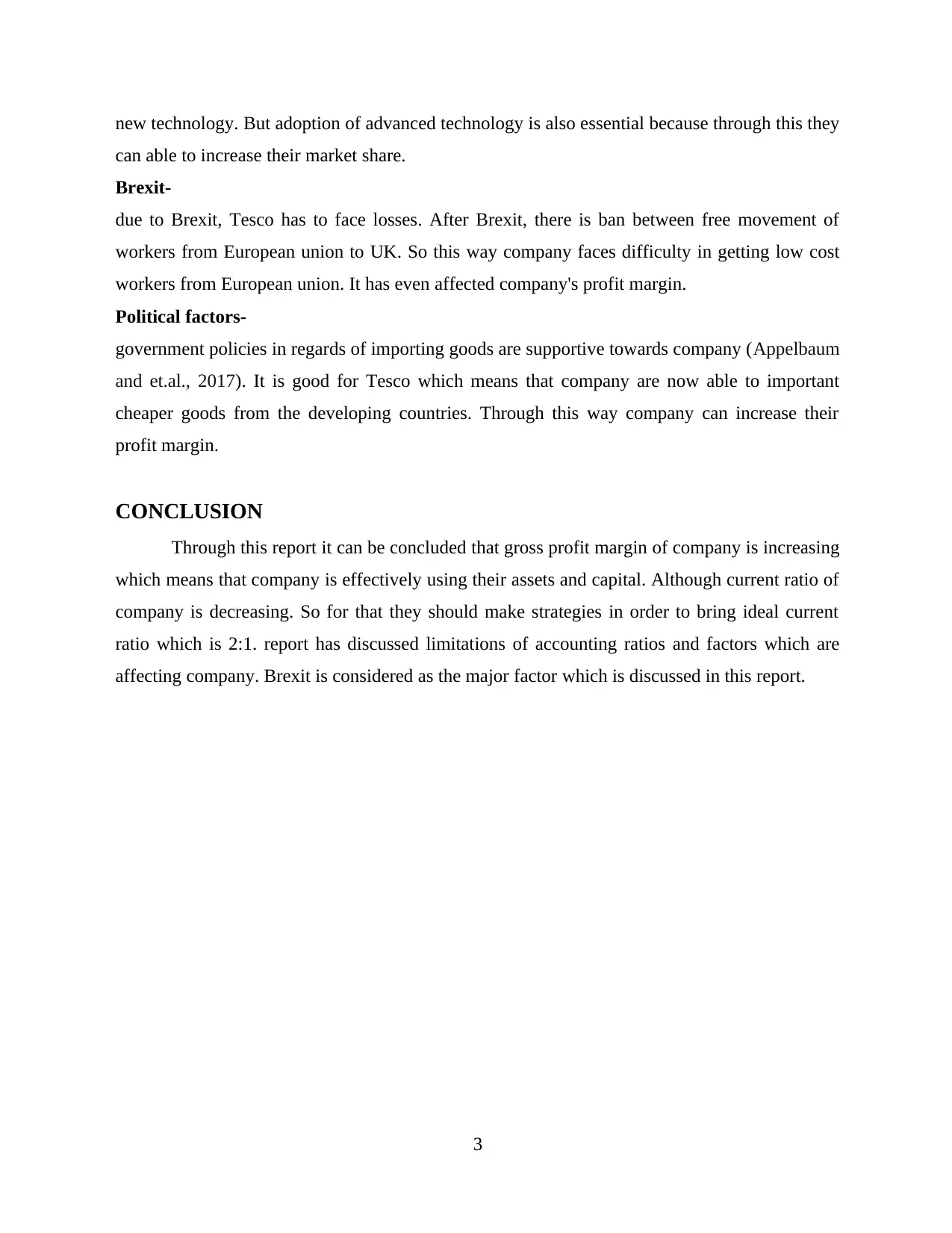
new technology. But adoption of advanced technology is also essential because through this they
can able to increase their market share.
Brexit-
due to Brexit, Tesco has to face losses. After Brexit, there is ban between free movement of
workers from European union to UK. So this way company faces difficulty in getting low cost
workers from European union. It has even affected company's profit margin.
Political factors-
government policies in regards of importing goods are supportive towards company (Appelbaum
and et.al., 2017). It is good for Tesco which means that company are now able to important
cheaper goods from the developing countries. Through this way company can increase their
profit margin.
CONCLUSION
Through this report it can be concluded that gross profit margin of company is increasing
which means that company is effectively using their assets and capital. Although current ratio of
company is decreasing. So for that they should make strategies in order to bring ideal current
ratio which is 2:1. report has discussed limitations of accounting ratios and factors which are
affecting company. Brexit is considered as the major factor which is discussed in this report.
3
can able to increase their market share.
Brexit-
due to Brexit, Tesco has to face losses. After Brexit, there is ban between free movement of
workers from European union to UK. So this way company faces difficulty in getting low cost
workers from European union. It has even affected company's profit margin.
Political factors-
government policies in regards of importing goods are supportive towards company (Appelbaum
and et.al., 2017). It is good for Tesco which means that company are now able to important
cheaper goods from the developing countries. Through this way company can increase their
profit margin.
CONCLUSION
Through this report it can be concluded that gross profit margin of company is increasing
which means that company is effectively using their assets and capital. Although current ratio of
company is decreasing. So for that they should make strategies in order to bring ideal current
ratio which is 2:1. report has discussed limitations of accounting ratios and factors which are
affecting company. Brexit is considered as the major factor which is discussed in this report.
3
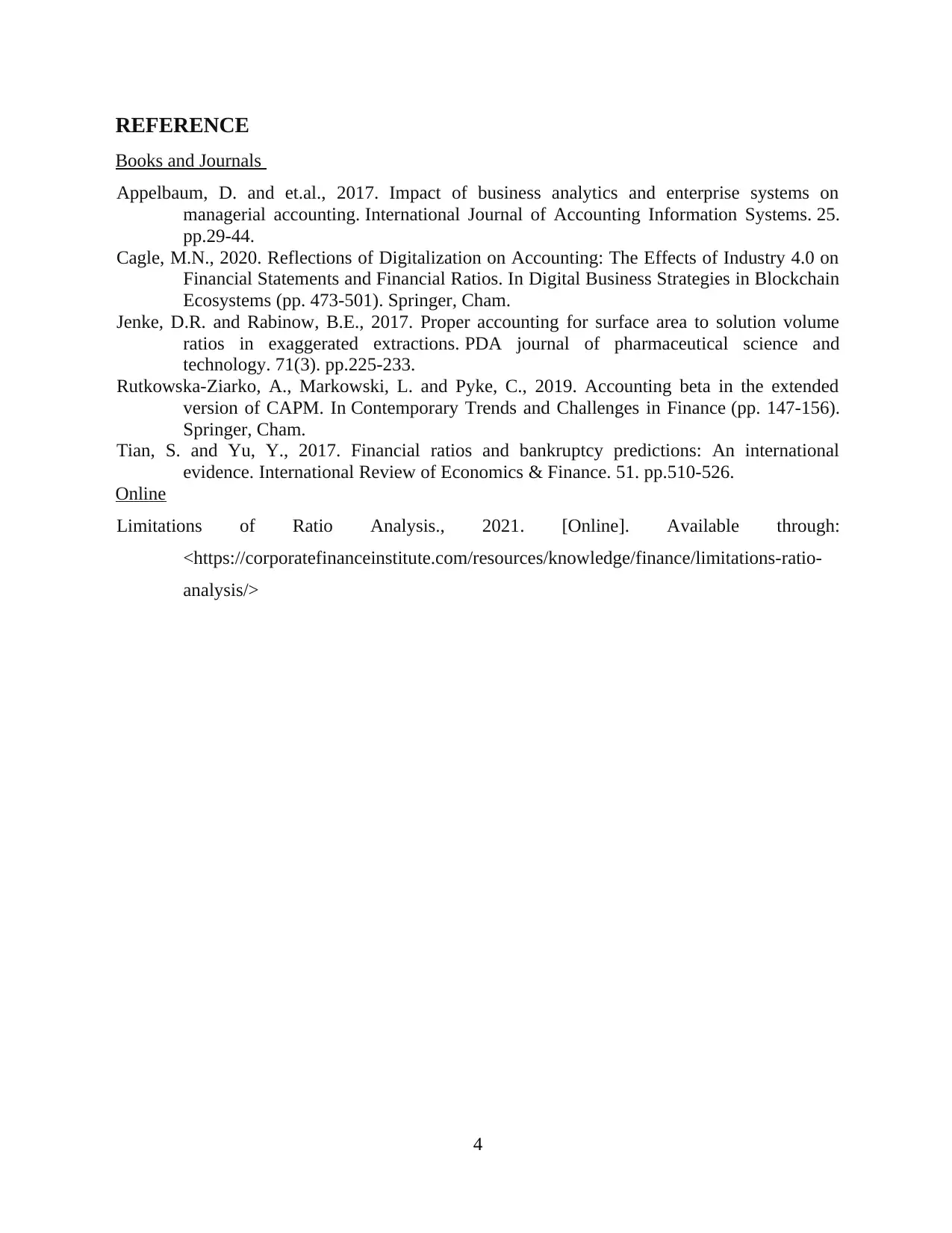
REFERENCE
Books and Journals
Appelbaum, D. and et.al., 2017. Impact of business analytics and enterprise systems on
managerial accounting. International Journal of Accounting Information Systems. 25.
pp.29-44.
Cagle, M.N., 2020. Reflections of Digitalization on Accounting: The Effects of Industry 4.0 on
Financial Statements and Financial Ratios. In Digital Business Strategies in Blockchain
Ecosystems (pp. 473-501). Springer, Cham.
Jenke, D.R. and Rabinow, B.E., 2017. Proper accounting for surface area to solution volume
ratios in exaggerated extractions. PDA journal of pharmaceutical science and
technology. 71(3). pp.225-233.
Rutkowska-Ziarko, A., Markowski, L. and Pyke, C., 2019. Accounting beta in the extended
version of CAPM. In Contemporary Trends and Challenges in Finance (pp. 147-156).
Springer, Cham.
Tian, S. and Yu, Y., 2017. Financial ratios and bankruptcy predictions: An international
evidence. International Review of Economics & Finance. 51. pp.510-526.
Online
Limitations of Ratio Analysis., 2021. [Online]. Available through:
<https://corporatefinanceinstitute.com/resources/knowledge/finance/limitations-ratio-
analysis/>
4
Books and Journals
Appelbaum, D. and et.al., 2017. Impact of business analytics and enterprise systems on
managerial accounting. International Journal of Accounting Information Systems. 25.
pp.29-44.
Cagle, M.N., 2020. Reflections of Digitalization on Accounting: The Effects of Industry 4.0 on
Financial Statements and Financial Ratios. In Digital Business Strategies in Blockchain
Ecosystems (pp. 473-501). Springer, Cham.
Jenke, D.R. and Rabinow, B.E., 2017. Proper accounting for surface area to solution volume
ratios in exaggerated extractions. PDA journal of pharmaceutical science and
technology. 71(3). pp.225-233.
Rutkowska-Ziarko, A., Markowski, L. and Pyke, C., 2019. Accounting beta in the extended
version of CAPM. In Contemporary Trends and Challenges in Finance (pp. 147-156).
Springer, Cham.
Tian, S. and Yu, Y., 2017. Financial ratios and bankruptcy predictions: An international
evidence. International Review of Economics & Finance. 51. pp.510-526.
Online
Limitations of Ratio Analysis., 2021. [Online]. Available through:
<https://corporatefinanceinstitute.com/resources/knowledge/finance/limitations-ratio-
analysis/>
4

5
Paraphrase This Document
Need a fresh take? Get an instant paraphrase of this document with our AI Paraphraser

6

7
1 out of 9
Related Documents
Your All-in-One AI-Powered Toolkit for Academic Success.
+13062052269
info@desklib.com
Available 24*7 on WhatsApp / Email
![[object Object]](/_next/static/media/star-bottom.7253800d.svg)
Unlock your academic potential
© 2024 | Zucol Services PVT LTD | All rights reserved.





